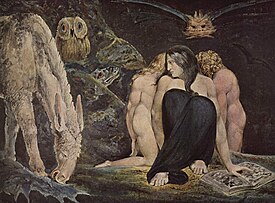Vala, or The Four Zoas
The eponymous main characters of the book are the Four Zoas (Urthona, Urizen, Luvah and Tharmas), who were created by the fall of Albion in Blake's mythology.
Blake intended the book to be a summation of his mythic universe but, dissatisfied, he abandoned the effort in 1807, leaving the poem in a rough draft and its engraving unfinished.
An early draft begins:[3] This is the Dirge of Eno which shook the heavens with wrath And thus beginneth the Book of Vala which Whosoever reads If with his Intellect he comprehend the terrible Sentence The heavens shall quake, the earth shall move & shudder & the mountains With all their woods, the streams & valleys: wail in dismal fear[3] In the second "night", the theme of women ruling is discussed but there is an emphasis on how the ability to create constricts them.
Wisdom is sold in the desolate market where none come to buy And in the witherd field where the farmer plows for bread in vain[4] The final "night" describes Los witnessing a vision of Christ's crucifixion at the hands of Urizen.
Folding like scrolls of the Enormous volume of Heaven & Earth With thunderous noise & dreadful shakings racking to & fro, The heavens are shaken & the Earth removed from its place[5] Vala concludes:[6] ...Urthona rises from the ruinous walls In all his ancient strength to form the golden armour of science For intellectual War.
This emphasis on free sexuality occurs in The Marriage of Heaven and Hell, Visions of the Daughters of Albion, and Blake's designs based on the Book of Enoch.
[8] In particular, Blake's God/Man union is broken down into the bodily components of Urizen (head), Urthona (loins), Luvah (heart), and Tharmas (unity of the body) with paired Emanations being Ahania (wisdom, from the head), Enitharmon (what can't be attained in nature, from the loins), Vala (nature, from the heart), and Enion (earth mother, from the separation of unity).
[9] As connected to Blake's understanding of the divine, the Zoas are the God the Father (Tharmas, sense), the Son of God (Luvah, love), the Holy Ghost (Urthona, imagination), and Satan who was originally of the divine substance (Urizen, reason) and their Emanations represent Sexual Urges (Enion), Nature (Vala), Inspiration (Enitharmon), and Pleasure (Ahania).
These thoughts carried over into Vala as the character Los (imagination) is connected to the image of Christ, and he added a Christian element to his mythic world.
[11] In 1945, Northrop Frye claimed: "There is nothing like the colossal explosion of creative power in the Ninth Night of The Four Zoas anywhere else in English poetry.
"[12] G. E. Bentley Jr., in 2003, believed that Blake's "most extraordinary achievement" between the "prodigious years" of 1795 and 1800 was Vala in addition to claiming that "The poem provides a profound analysis of man's limitations but no hint of escape from the prison".


